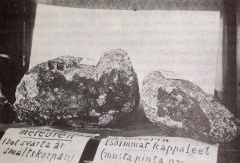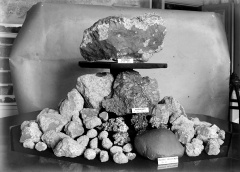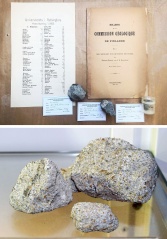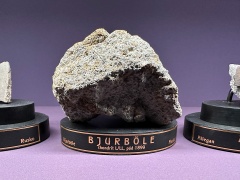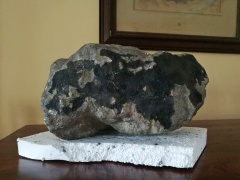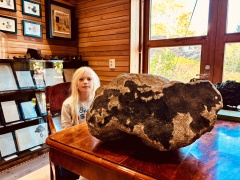(Unless otherwise stated, the copyright of the materials included belong to Jan Woreczko & Wadi.)
Bjurböle
Z Wiki.Meteoritica.pl
This page was edited by Jarkko Kettunen.
| Bjurböle → | |
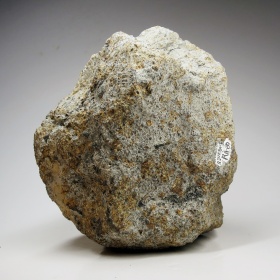
Fragment 3 kg; collection Jarkko Kettunen (size: 11.0×9.0×8.0 cm)
| |
| Fell | |
| Location | Porvoo, Uusimaa, Finland |
| Coordinates[1] | 60°24'N, 25°48'E |
| Date | Mar. 12, 1899, 22:30 |
| Remarks | it is one of the few meteorites found underwater |
| Characteristics | |
| Class | ordinary chondrite, L/LL4 |
| Mass | 328 kg |
| Pieces | one piece broke into many pieces |
| Meteoritical Bulletin Database | |
| Synonyms → | |
| in NHM Cat: Bierbele, Bjorböle, Bjurboele; fin. Bjurbölen meteoriitti | |
Bjurböle is the biggest meteorite ever found in Finland. The total weight of the founded pieces is 328 kg. Later it became clear that some of the men who lifted the meteorite pieces from the bottom of the sea, had took some pieces for them shelves. Those pieces were sold to different people in the area of town Porvoo. When this mass is added to the 328 kilos the total weight of the Bjurböle meteorite was around 400 kg.
On the 12th of March 1899 a bright fireball was seen over the Baltic sea. In the capital of Finland, in Helsinki, this event aroused great attention. The newspaper Päivälehti told the following:
“A big bright meteor with a long blasing tail whizzed over our city at 9:30 pm from northwest to southeast. The meteor lightened it's surroundings like a gigantic electric bulp. The clouds seemed to be golden-haired and spreaded hither and thither. After about one minute meteor broke into small pieces with a terrible thunder. This sound lasted many minutes. The bang made the houses shook up to their foundations. People hastened out of their apartments and houses to streets and yards. Some thought it was big cannons firered in the Fortress Viaborg and some thought it is the end of the world. If we have it correct, the same phenomenon was seen in the western and eastern side of the city. To get a better knowledge about this phenomenon we urge citizens to send their observations to the weather observatory. It is important to know when and how long the phenomenon was seen, how much time was between the appearance of the meteor and the thunder, how long thunder lasted and what direction the phenomenon went. It would be good if the viewer would have drawing showing the direction of the meteor compared to the location of the viewer.”
These witness reports were important to get a good information of the meteors trajectory. The fireball was seen all around Baltic sea and Southern Finland. The fireball passed Helsinki from the south side, over the Baltic sea. The altitude was around 20 kilometer. The fireball hit an ice covered sea bay on the southern side of the town Porvoo, 50 km east of Helsinki. Next day a 3-4 meters wide hole in the ice was found close to the shore. A big amount of mud was spread all around the hole in the ice. Meteorite had went through the 40 cm thick ice. The water was only 50 cm deep under the ice, but after that there was a 8 meters deep layer of mud and clay before the bedrock. With long sticks people tried to find the meteorite itself, but that did not succeed in the beginning. Because it was sure that this was exact the point were the meteorite had hit it was build a waterproof wooden well out of wooden beams. This wooden well was shunken through the hole in the ice to the bottom of the mud layer. Then well was emptied out of water and mud. This did not succeed completely, but in the end a diver was able to find the meteorite and pulled the pieces up to the ice.
The biggest pieces weight 80, 21, 18 and 17 kg. The biggest piece is 30-40 cm thick. The whole meteorite has been 1 m wide before break down to pieces. After the meteorite was recovered it needed to dry before it was able to be researched. Bjurböle meteorite is very soft and fragile material and breaks very easy. Bjurböle is a ordinary chondrite with great chondrules that size from very small to the size of fingertip. Two owner of the property where the meteorite had fallen received a 500 Finnish marks compensation for the damages that has happened to the fish spawning place. This money was given forward to the benefit of the local school.
Bjurböle is the biggest fall in Scandinavia with an extraordinary history. It is one of the few meteorites found underwater.
Collections
Fragments of the Bjurböle meteorite in the largest collections:
Collection weight of fragments
(Koblitz MetBase)remarks Helsinki, Geol. Mus. Univ. 210 kg [approx. weight] Stockholm, Naturhist. Riksmus. 21.2 kg Chicago, Field Mus. Nat. Hist. 5641 g Washington, Natl. Mus. Nat. Hist. 4 kg (…) Warsaw, Geol. Inst., Polish Acad. Sci. 262 g by Pilski (2001) [g]: 111.26 (fc), 44.51 (f), 13.34 (fc)
Location
(B) Bjurböle, (P) Porvoo
* W 2018 roku Google zmieniło zasady działania apletu, mapa może wyświetlać się niepoprawnie (pomaga Ctrl+F5); więcej → Szablon:GEMap-MyWiki
Galleries
Ramsay et al. (1902)
A historic photo of Bjurböle and Marjalahti[2] meteorites, the two biggest meteorite falls in Finland. Here is presented the main masses with some additional pieces, including the main mass of Hvittis.[3] Now in the collection of Luonnontieteellinen keskusmuseo, Geologinen museo in Helsinki |
Fragment 226.4 g; collection Jan Woreczko |
||
Fragment in the collection Prague Natural History Museum (fot. Szymon Kozłowski) |
Fragments 111.26 (fc), 44.51 (f), 13.34 (fc) in the collection Muzeum Geologiczne PAN w Krakowie |
Fragment 111.26 (fc) in the collection Muzeum Geologiczne PAN w Krakowie (fot. Szymon Kozłowski) |
Fragment ~37 g in the collection Państwowy Instytut Geologiczny w Warszawie (fot. Szymon Kozłowski) |
A cast of the fragment exhibited at the World's fair, Paris 1900; now a museum in Helsinki |
A cast of the main mass (~83 kg) of the Bjurböle meteorite (in the meteorite room of Jarkko Kettunen's collection, his daughter Emilia is sitting at the desk) |
Bibliography
- Koblitz Jörn, MetBase. Meteorite Data Retrieval Software, Version 7.3 (CD-ROM), Ritterhude, Germany 1994-2012. MetBase.
- Łaptaś Andrzej, Ćwiżewicz Małgorzata, (1998), Meteoryty w zbiorach Muzeum Geologicznego w Krakowie, Muzeum Geologiczne ING PAN, Kraków 1998, ss. 34. ISBN 83-909970-1-0.
- Moilanen Jarmo, Kettunen Jarkko, (2016), Takaisin Bjurböleen!, Tähdet ja avaruus, 3, 2016, p. 42-45.
- Oja Heikki, (1978), Tulipalloja taivaalla, Tähtitieteellinen yhdistys Ursa, Helsinki 1978, pp. 208.[4] File doi.
- Ramsay Wilhelm, Borgström Leonhard Henrik, (1902), Die Meteorit von Bjurböle bei Borgå (Mit 20 Figuren im Text), Bulletin de la Commission Géologique de Finlande, nr 12, Helsingfors 1902, pp. 28.[5] Plik PDF.
Footnotes
See also
External links
- Meteoritical Bulletin Database (MBD) – meteorite Bjurböle
- Encyclopedia of Meteorites (EoM) – meteorite Bjurböle
- Fińskie Muzeum Historii Naturalnej w Helsinkach (Finnish Museum of Natural History, University of Helsinki; Helsinki, Geol. Mus. Univ.) – Luonnontieteellinen keskusmuseo, Helsingin yliopisto ● Exhibitions in the Mineral Cabinet
- Wikimedia – Finnish meteorites - Meteorites in the Arppeanum



